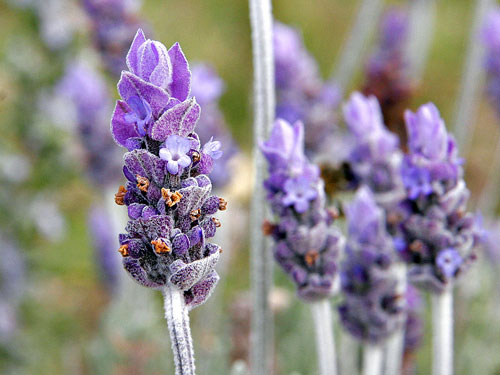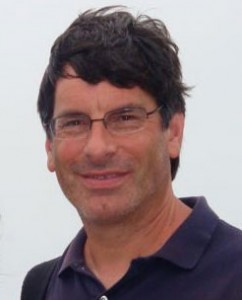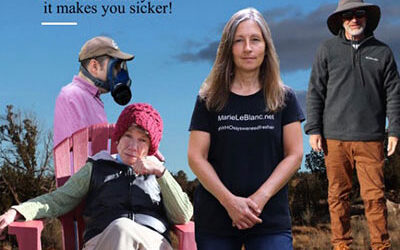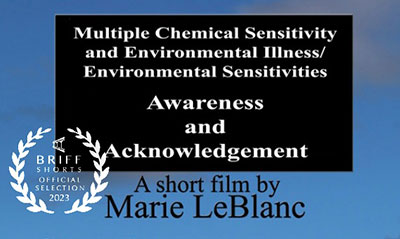Jack Rossi’s memoir of his experience with MCS, being forced outdoors and his insight into the Vermont landscape, health and healing and the fragile planet we inhabit

Field of Lavender photo by Fir0002/Flagstaffotos | GNU Free Documentation License
I’ve just reached a place
Where the willow don’t bend.
There’s not much more to be said
It’s the top of the end.
I’m going,
I’m going,
I’m gone.
~ Bob Dylan, Going, Going, Gone
It was always creeping in my direction. I can see that clearly now. A stealthy predator stalking – waiting for the opportune time to strike. Not once, but repeated times – and each strike a subtle blow to my body’s ability to protect itself; tearing down my resistance only to increase my vigilance and apprehension. Where would the next strike come from? I’ve organized them now in my memory like a computer file.
There was the cheap veneered chest of drawers my mother brought home when I was twelve years old to alleviate a crowded closet shelf of sweaters. An innocent white cardboard box harboring a menacing do-it-yourself kit of veneered particleboard, pine knobs and wood screws that with twenty minutes of the purchaser’s time would birth an instant dresser. The offending odor apparently didn’t bother anyone else but me (a continuing theme) – my mom still tells me I complained of the ‘stink’ it emitted and pleaded with her to “get it out of here”.
Sure it spoke to all I despised. Wood dust mixed to slurry with all sorts of chemicals, molded into a mass-produced inexpensive, artless box that in one stroke relegated handcrafted furniture and natural materials to a dusty back shelf in the market of mass consumerism. Society’s ills were important to me, even at a young age, but I could have lived with this particular insult if only the damn thing hadn’t made me sick.
Several years later I visited my dad and stepmother outside Phoenix where they had recently retired. Eager to show me the reasonably priced housing going up in the area, they took me on a house viewing expedition as an enticement to consider moving out there myself. We visited a new condominium development about 20 miles south of Phoenix, one of too many residential housing projects quickly eating up the pristine Sonoran desert. Sandi and I toured a two-bedroom open house unit. I remember walking into the tightly sealed box of invisible plywood, particleboard and insulation insidiously hidden behind a beautiful skin of new kitchen cabinetry, synthetic carpeting, plaster and paint. The desert tone wall and carpet colors were tastefully done – a visual treat that contradicted my sudden, troubling physical symptoms. The cool, recirculated air burned my nasal passages. Breathing became oppressive. The longer I remained in the unit, the worse I felt. Feeling cloaked in a mist of chemical odor, penetrating my eyes, skin and lungs, it was difficult to focus on anything and I became far more interested in getting out of the building than seeing its ‘charms’. I sensed my reaction was ‘abnormal’; others were very content taking in the various rooms with no indication of troubling symptoms. But I also realized, symptoms or not, the air in this building was toxic and prolonged exposure couldn’t be healthy. I sympathized with the family who would ultimately purchase the property and reside here on a daily basis.
The infrequency of these occurrences made them more curiosities to me than anything else at the time. I was aware of being ‘sensitive’ but never considered this could be the precursor to a complex disorder or ‘condition’. That all changed in early 2000.
We had been living in Newburyport, Massachusetts for about a year. Sandi was working at home, in what was still a new community, with little outside contact, Jon and Lane were attending the Cape Ann Waldorf School in Beverly Farms (a forty minute commute each way that we shared with another family) and I was working in Cambridge as a senior landscape architect with Carr Lynch and Sandell, in a position I had sought for many years. An iconic landscape architectural and urban planning firm: the founder, Kevin Lynch, had literally written the book (in fact, many) on urban design and city planning. I’d read several of his books in graduate school and knew that many of his design principles were highly regarded in the international urban design community. Not to mention I was making good money, collaborating with incredibly talented people and respected for my contributions.
But collectively this lifestyle was taking a toll on our happiness and sense of peace. Sandi felt a yearning for a simpler existence where she could be closer to the kids, their school and a purposeful community. I was commuting an hour and a half each way to and from Cambridge – only barely tolerating the daily traffic and city noise – getting home on a good night at 7:30; just in time to get the kids in bed and then collapse myself. Maybe subconsciously I was already preparing for a change, as I’d often search the web for other job opportunities, yet never intended to act on them, and up to that point, hadn’t. When one evening I came across a job listing on the American Society of Landscape Architects’ website seeking an experienced designer for a small office in central Vermont I felt like I’d had an epiphany. I wasted no time pursuing it. After a couple phone inquiries, I polished up my resume and portfolio and sent them off with a solid cover letter. Within a month I had secured the job and found myself in Woodstock, Vermont looking for a place to live.
That first morning at my new office, sitting at my drafting table in the large one room slate-floored timber frame office, surrounded by pine bookshelves and large clear windows, opened slightly to invite in a cool breeze, and the sound of chirping birds, I felt as if I’d stepped back in time hundred years from the dirt and bustle of Boston. That evening I called family and friends incredulously explaining how I had traded my third story ‘attic’ window view of Inman Square’s asphalt intersection and the pigeon-shit covered top of a wooden utility pole for a sweeping vista of blue-green hills and a beautiful meadow where two centuries ago Ethan Allen’s Green Mountain Boys used to practice military drills. Now the only visible traffic consisted of flocks of wild turkeys, herds of deer and an occasional lone fox.
Suddenly I was working for well-known philanthropists, politicians, business leaders, authors and musicians. We designed and oversaw the construction of incredible landscapes for rustic country cottages and ski homes to elaborate grand estates. The typical landscape treatment often included extensive field stone walls, terraces, and stairs, swimming pools, spas and pool houses, beautifully crafted wooden garden structures like pergolas, arbors and trellises, fountains, dry stream beds, and plantings including apple orchards, sugar maple groves and allees, lilac copses, native wildflower meadows and amazing perennial gardens. We were doing work in Pennsylvania, Maine, Massachusetts, Connecticut and New York but most of the activity was regional, the Upper Valley area of Vermont and New Hampshire.
Ask anyone in the region what the boundaries of the “Upper Valley” are and you’ll get as many different answers. As I understand it the phrase was derived as a description for a fledgling newspaper’s coverage region.
In the early 1950’s, Allan Butler and Jim Farley were reporters with the Claremont Daily Eagle. After the unexpected death of the Eagle’s owner, John McLane Clark, Butler and Farley started their own publication, the Valley News. Butler derived the term ‘Upper Valley’ to designate, and in a sense, mark, the northern half of the Eagle’s distribution territory.
This area of lower central Vermont and New Hampshire straddles the Connecticut River and includes the towns of Woodstock, White River Junction and Norwich, Vermont and Lebanon and Hanover, New Hampshire. Hanover is an affluent town of approximately 11,000 people, best known as the home of Dartmouth College. Lebanon, Hanover’s more commercialized neighbor derived its name from Lebanon, Connecticut, where many of its early settlers had moved from in the mid-1700s. It contains a large retail-shopping district in the village of West Lebanon, numerous small industries and Dartmouth Hitchcock Memorial Hospital, the largest employer in the region, which recently saw the completion of an expansion project that increased the facility by thirty percent. Woodstock, arguably the prettiest small town in the United States, has been a major tourist destination since the late 1800’s. This popular designation and destination helped in no small way by its historic architecture, village green, covered bridges, the Ottauquechee River and the surrounding foothills of the Green Mountains. Following early environmentalists and residents, George Perkins Marsh and Frederick Billings, Laurance Rockefeller and his wife Mary French used their wealth and influence throughout the mid to latter twentieth century to continue the heritage of land conservation and sustainable land use by establishing the Woodstock Foundation, the Billings Farm and Museum and eventually in 1992, the first national park in the state, the Marsh-Billings-Rockefeller National Historic Park.
The entire Upper Valley area has seen tremendous growth over the last twenty-five years. Wealthy individuals and families from New York, Boston and points further south and west, continue to seek second home properties in the area. ‘Flatlanders’ from southern New England and the mid-Atlantic region, frustrated with unrestrained growth, heavier traffic and increased crime in their states have found a healthy environment here for entrepreneurial pursuits, employment, and schools, while many Dartmouth graduates eventually return to the area, nostalgic for the bucolic setting of their college years.
There are still many parts of the state that don’t share this relative affluence and comfortable living though, and I should add, this includes parts of the Upper Valley as well. Venture into the hills outside the old mill towns or farming villages that haven’t found their stride in the 21st century and you’ll find neglected, rundown houses, rusted trailers and mobile homes on unkempt, overgrown properties. Unemployment, drugs, abuse, crime; the ugly stepsiblings of poverty, still exist.
For me though, my exposure to Vermont in my new position came through a discriminately focused, if not biased, lens. Money, and the desire to spend it lavishly; on art, architecture and gardens was the fuel for this business and where the firm prudently put its attention.
The office initially consisted of Brett, the owner, and myself. Shortly after my arrival we hired another landscape architect, Julia, and the three of us enjoyed a compatible and satisfying working relationship. The office seemed to have a regularly revolving part-time office manager position, sometimes male, sometimes female, and never lasting, for any number of reasons, more than a year. Occasionally Gail, a long-standing employee from the early days (she was the original office manager), would come in and do perennial garden design. As the firm became busier Gail took on a more prominent role in the daily activity of the office, and our interactions became more frequent. She was a fun, smart, high energy and highly emotional woman in her late thirties and I thoroughly enjoyed working with her.
On one morning in early spring Gail came through the door in her usual bubbly manner trailing an incredibly pungent floral scent. The residual air currents from her swift gait past my desk sent the thick fragrance swirling throughout the small, closed-windowed office. At first I thought nothing beyond this being a bold personal statement: not necessarily out of character for Gail. But within five minutes I felt completely under the spell of this fragrance. My eyes felt irritated. I was light-headed. I felt my heart palpitating and my focus and attention became a quivering mass of jell-o. Within a half hour I reached an equilibrium point – I wasn’t getting any worse but I sure as hell wasn’t feeling any better. My concentration and intellectual capabilities were beyond their reserves, I was lucky to be working at fifty percent of my normal capacity. What could I say? This had hit me like an angry hornet out of nowhere. I silently tolerated the day, escaping outdoors for short breaks of fresh air as often as possible without signaling a problem, yet gaining no relief from the attempt.
When I got home that evening the symptoms had leveled to a general anxiety and malaise. Overnight my dreams were vivid but extremely disjointed and atypical. I was never a big drug user but this felt like what I imagined a mildly ‘bad trip’ to be like. By morning the worse effects had worn off and although I was groggy I was feeling much more like myself. Initially, I denied the significance of the reaction I had and assumed this had been an isolated incident, unlikely to occur again. Wrong! About a week later it happened again. Same overpowering floral scent; same reaction. Fortunately Brett and I had a field day planned and we left the office shortly after Gail arrived. Even with that short exposure I succumbed to a daylong bout of dizziness, blurry vision and disorientation. In the truck I spoke up to Brett.
“Gail’s been wearing some pretty strong perfume lately. Has it bothered you at all?”
“I hadn’t really noticed,” he said complacently.
Hadn’t noticed? Had I heard that correctly? I was floored by the comment. The scent was overwhelming. It screamed for attention and had played havoc on my body to ensure it was noticed. How could he not be aware of it? I’d hoped for some empathetic support, not a brush off. I felt completely defeated in gaining any managerial support on preventing future surprises.
It hadn’t occurred to me until that moment that I might be reacting more intensely to this than anyone else. To others it was a fragrance, a simple, albeit, strong smell. That’s as far as it went: no symptoms, no big deal. I didn’t comprehend why, but it seemed that this wasn’t a universal experience but rather something happening to me personally, and I had to protect myself from it.
I had to let Gail know that whatever she was wearing was affecting me in a very bad way. The only way I saw that occurring was for me to be truthful and direct. When I told Brett that I planned to speak with her about it, the expectation was that this time he might support my plight by speaking with her first in my behalf, indicating that I was in distress. But no, he wasn’t getting in the middle of this time bomb. While disappointed, I couldn’t blame him. Gail had a strong personality and who knew where this might go. With a sheepish look and friendly smile that pleaded with me to sympathize with his position, he lamented, “that ought to be an interesting conversation”. I was on my own.
For the next several days I rehearsed the conversation I would have with Gail over and over in my head. Every time around it replayed a little differently. There’s no tactful way to tell someone that her choice of personal hygiene is making you sick. I also felt like I was crossing a line and getting into her personal space – who was I to tell her what she should or should not wear? Brett was right; this was going to be an interesting conversation.
People have described me as a pretty ‘easy-going guy’. I don’t enjoy confrontations; I never have. I’m intuitive and understand human nature fairly well. We all have our quirks and life’s lessons to learn and I’m pretty forgiving that way. As long as no one gets hurt I’m happy to let mildly abrasive situations settle themselves, which they usually do. Unfortunately this situation was more than mildly abrasive. I was getting hurt and I had to say something. I reversed the situation and thought what if I was wearing something that was making someone else physically ill, wouldn’t I want to know about it, and wouldn’t they most likely be inclined to tell me? Absolutely. With this rationale I had all the justification I needed to call her.
Other than a cold call to a girl I was wildly infatuated with in high school, and had never personally spoken to, this was the most difficult call I’d ever made. I procrastinated for days, waiting for the right time. Finally realizing there was never going to be a right time, I stopped thinking about it, picked up the phone and dialed.
“Hey Gail, it’s Jack.”
“Oh, hi. What’s up?’”
“Sorry to bother you at home but I wanted to catch you tonight in case I didn’t see you in the morning. I wouldn’t even be mentioning this at all if it wasn’t becoming such a problem for me, but I wanted to ask you about the perfume you’ve been wearing at work lately.” There it was! I was teetering on a narrow plank, balancing between trying to be tactful, non offensive and maintaining a respectable working relationship with a colleague while expressing the concern dramatically enough to ensure it was taken seriously. A brief silence presented itself, or I just feared it would, so I spoke again.
“For some reason it’s really bothering me. I’m getting terrible headaches, heart palpitations, dizziness and honestly, I’m having a very tough time concentrating on my work.”
“Wow… I’m not sure what to say. I don’t know what it could be.”
“It’s really floral. I’ve only noticed it the last couple of weeks.”
“The only thing I’ve used lately is lavender oil, and that’s an essential oil. Believe me, I’m very sympathetic to concerns about perfume.”
“Hmm, that must be it – very strange.”
“Yeah, I’ve never heard of that being a problem for anyone.”
“I don’t get it either, but for some reason it’s playing havoc with my body.”
Gail was sympathetic and very graceful. She offered to not wear it at the office any more. I was grateful for the concession on her part, but even more so for having survived the phone call. She kept her promise. Months went by without an incident. Then one morning she just forgot. The first scent I inhaled sent me reeling. This time it would be two and a half days before I felt like myself again. I was becoming more reactive with each exposure.
(Note: I never understood the relationship of lavender oil to my strong physiological symptoms until I came across an obscure research article years later. It indicated an association with certain essential oils, lavender in particular, and its potential for symptom inducing effects on chemically sensitive individuals.)
Shortly after that episode, and not because of it, I left that office and started my own firm in my home in South Strafford.
read more:
Introduction
Chapter 1 ~ The Wonder Years
Chapter 2 ~ Evolution of an Illness
Chapter 3 ~ Changes
Chapter 6 ~ A New Beginning
 Jack Rossi is principal and owner of Jack Rossi Landscape Architecture, Woodstock, VT, a landscape architectural firm, specializing in sustainable landscape design. He’s also an adjunct professor of landscape architecture and sustainable design at Vermont Technical College and author of the forthcoming book on multiple chemical sensitivity and the environment, InsideOut.
Jack Rossi is principal and owner of Jack Rossi Landscape Architecture, Woodstock, VT, a landscape architectural firm, specializing in sustainable landscape design. He’s also an adjunct professor of landscape architecture and sustainable design at Vermont Technical College and author of the forthcoming book on multiple chemical sensitivity and the environment, InsideOut.









I really enjoyed this story and was very impressed to hear how Jack handled this really sticky situation. J8